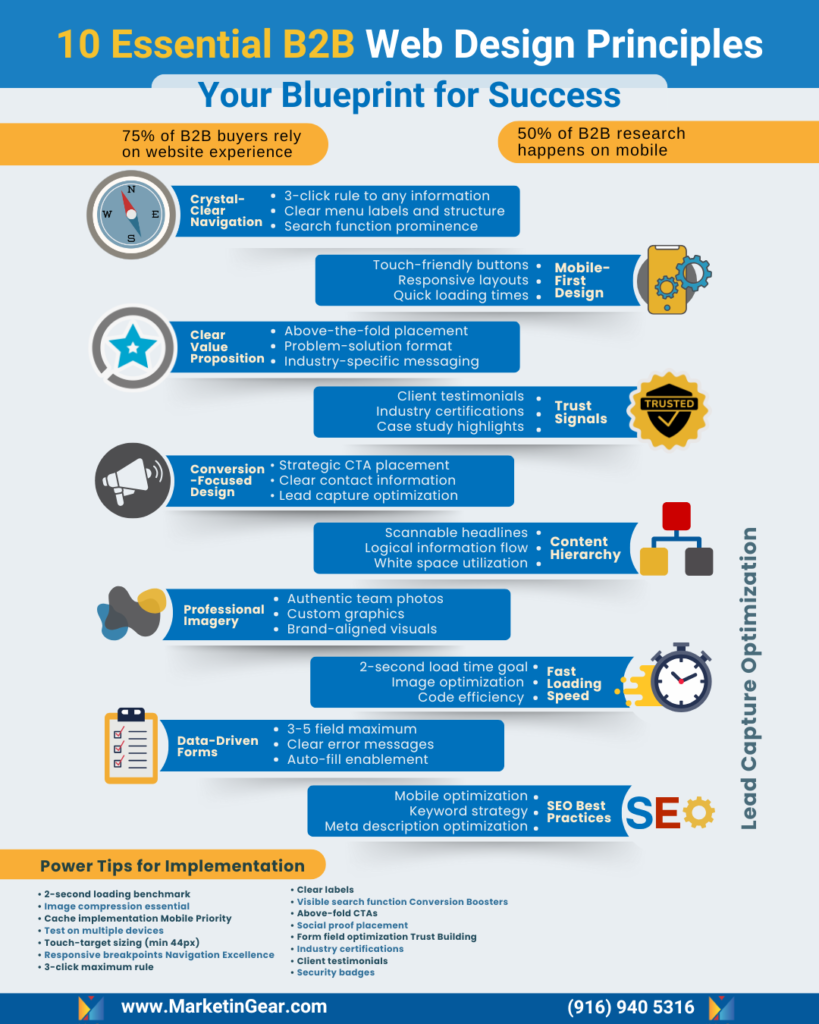In today’s digital marketplace, your website isn’t just a digital business card – it’s your hardest-working salesperson! For small businesses and B2B companies, building a professional website is essential for driving conversions, building trust, and standing out. Let’s dive into the tried-and-true principles that make B2B websites not just look great but actually drive results. Trust me, by the end of this guide, you’ll be seeing websites in a whole new light!

Table of Contents
- Introduction: Why B2B Web Design Matters
- The Golden Rules of Professional B2B Websites
- 10 Unbreakable Principles for Success
- Implementation Guide
- Real-World Success Stories
- Getting Started
Introduction: Why B2B Web Design Matters
Picture this: You’re cooking up an amazing meal, but your kitchen is a total mess – pots everywhere, ingredients scattered, and the recipe is written in tiny, unreadable text. Frustrating, right? That’s exactly how potential clients feel when they land on a poorly designed B2B website!
In B2B interactions, your website often serves as the primary touchpoint. Did you know that 75% of B2B buyers base their purchase decisions on website experience? For small businesses and service companies, an effective B2B web design means creating a seamless, attractive, and intuitive experience that sets the foundation for trust and engagement. Small business web design is about rolling out the digital red carpet and guiding visitors to make meaningful connections with your brand.
The Golden Rules of Professional B2B Websites
Before we dive into the top 10 principles, let’s get one thing straight: B2B web design may not be rocket science, but it requires careful attention to detail and a clear understanding of your audience’s needs. Think of it like baking a cake – you need all the right ingredients in the right proportions.
The following principles are fundamental to creating professional B2B websites. These principles provide a structure that guarantees visitors can navigate your site easily, trust your brand, and, ultimately, take action.
10 Unbreakable Principles for Success
1. Crystal-Clear Navigation
Remember playing hide-and-seek as a kid? Well, your website visitors don’t want to play that game! Clear navigation is a fundamental part of B2B website principles because it reduces friction and helps users find what they’re looking for quickly. Aim to keep navigation as intuitive as possible:
- Use descriptive menu labels – “Services” is great, but “Digital Marketing Services” is even better.
- Implement a logical hierarchy – Start broad and narrow down.
- Include a search function – A search bar helps visitors find what they need faster.
- Add breadcrumb navigation – This helps visitors track their journey and return to previous pages easily.
2. Mobile-First Design 📱
Did you know over 50% of B2B research happens on mobile devices? Mobile-friendly design is no longer optional; it’s a necessity. This affordable B2B web design best practice means ensuring your website looks as sharp on a smartphone as it does on a desktop:
- Touch-friendly buttons – Make it easy for users to click without zooming.
- Responsive images – Ensure images adjust well across all devices.
- Quick loading times – Reduce bounce rates by keeping your site snappy on mobile.
- Readable text – Make sure all text is legible without zooming in.
3. Clear Value Proposition
Imagine meeting someone new – you want to make a strong, clear first impression, right? Your website’s homepage needs to instantly communicate what makes your business unique:
- What do you offer? A concise tagline or headline can summarize this.
- Who is it for? Address your target audience directly.
- Why should they choose you? Outline your main selling points, like affordability, efficiency, or expertise.
A strong value proposition is particularly essential for B2B web design principles for small businesses in 2025, where competition can be fierce, and every second on your page counts.
4. Trust Signals
In B2B transactions, trust is priceless. Visitors need to feel secure before committing to a professional relationship with your brand. Here’s how to build trust through your website:
- Client testimonials – Showcase positive experiences from past clients.
- Industry certifications – Highlight any relevant qualifications.
- Case studies – Share specific examples that demonstrate success.
- Security badges – Assure visitors their information is safe.
- Professional associations – Align your brand with trusted industry bodies.
5. Conversion-Focused Design
Design your website with purpose. In small business B2B website conversion strategies, every page should guide visitors toward an action, whether it’s signing up, downloading content, or contacting your team. Think of it as leaving breadcrumbs:
- Strategic CTAs – Use clear calls-to-action that stand out on the page.
- Clear contact information – Don’t hide the ways users can reach out.
- Lead capture forms – Create simple forms that encourage contact.
- Chat functionality – Live chat can be a powerful tool for instant engagement.
6. Content Hierarchy 📚
Organize information so it flows smoothly and logically. Visitors should be able to scan the content quickly, getting the main points without feeling overwhelmed. For effective B2B web design, a clear content structure makes a massive difference:
- Compelling headlines – Start with a strong message that grabs attention.
- Scannable subheadings – Make it easy for visitors to find specific info.
- Bullet points – Summarize key details in bite-sized, digestible pieces.
- White space – Ensure your page isn’t cluttered, improving readability.
7. Professional Imagery
Stock photos have their place, but nothing beats real images that reflect your brand’s personality. Custom images can elevate custom web design for professional service firms:
- Use team photos – Humanize your brand with authentic images.
- Show your actual workspace – Give a behind-the-scenes look.
- Include product demonstrations – Visuals help explain services.
- Add relevant infographics – Make complex ideas easier to grasp.
8. Fast Loading Speed ⚡
In today’s fast-paced world, nobody wants to wait around for a website to load. Slow pages are one of the biggest turn-offs for visitors. By optimizing your website, you’ll retain more users and improve overall engagement:
- Optimize images – Use compressed images without losing quality.
- Minimize code – Reduce bloat to speed up loading times.
- Efficient hosting – Choose reliable servers.
- Enable caching – Faster load times for returning visitors.
9. Data-Driven Forms
Forms are critical in capturing leads but should be unobtrusive. Simple, efficient forms can make a world of difference in business website design tips:
- Ask only necessary questions – Focus on essential details.
- Use multi-step forms – Break complex forms into digestible steps.
- Auto-fill – Make it easy for users to complete forms quickly.
- Clear error messages – Help users understand and correct mistakes.
10. SEO Best Practices
If users can’t find your site, the best design in the world won’t matter. Implementing SEO best practices ensures your website ranks well and attracts the right audience:
- Optimized meta descriptions – Compel searchers to click on your page.
- Relevant keywords – Use keywords strategically throughout the content.
- Alt text for images – Make visuals accessible for both users and search engines.
- Mobile optimization – Ensure your site is responsive on all devices.
Implementation Guide
Now that you know the principles, let’s talk about putting them into action. Think of it like building with LEGO blocks – start with the foundation and work your way up.
1. Audit Your Current Site
Begin by evaluating your current website. Identify what’s working and where there’s room for improvement:
- What pages receive the most traffic?
- Are there any pages with high bounce rates?
- Are the pages optimized with relevant keywords like “professional B2B websites” and “small business web design”?
2. Set Clear Goals
Clear goals give your redesign a purpose. Define what success looks like for your website:
- Define success metrics – Track KPIs like lead conversions or bounce rate.
- Establish a timeline – Give each milestone a realistic deadline.
- Allocate resources – Designate who will handle each aspect.
3. Create a Plan
Prioritize changes based on your goals. Map out a schedule and assign responsibilities to your team.
Real-World Success Stories
To see the power of these principles in action, let’s look at a few examples:
- Sarah from Tech Solutions Inc.: “After implementing these design principles, our lead generation increased by 156% in just three months!”
- Mike from Professional Services Ltd.: “Our bounce rate dropped from 65% to 25% after redesigning with these principles in mind.”
Getting Started
Ready to transform your B2B website? Remember, Rome wasn’t built in a day, and neither is a great website. Start with the basics:
- Focus on user experience – User-friendly websites build loyalty.
- Prioritize mobile design – Mobile users are a huge portion of your audience.
- Build trust through content – Testimonials, case studies, and certifications matter.
- Test and optimize regularly – Continuous improvement keeps your site competitive.
Need Help?
Creating an effective B2B website doesn’t have to be overwhelming. Sometimes, having an experienced partner can make all the difference. Whether you’re starting from scratch or updating an existing site, we’re here to help!




